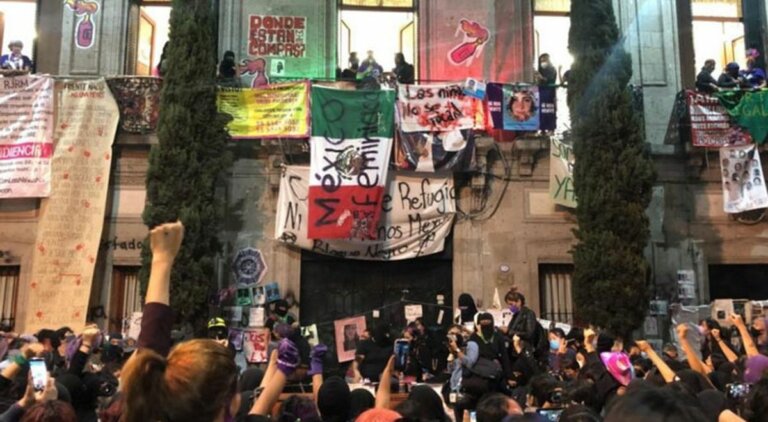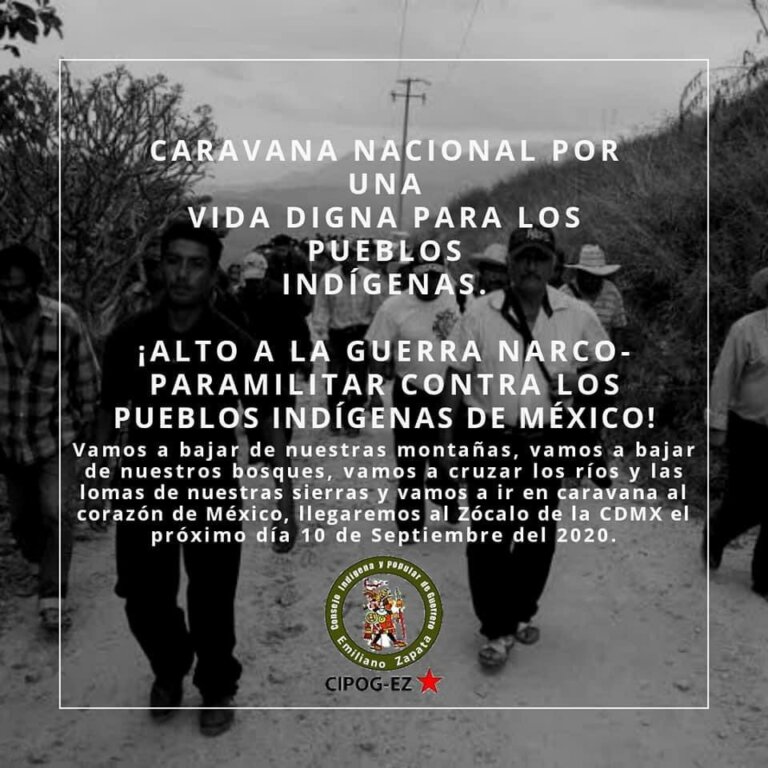By Scott Campbell
I didn’t translate this article because I think it’s good. Actually, it’s horrible. As you likely know, in October 2006, Indymedia journalist Brad Will was shot and killed in Oaxaca while covering the uprising there. There is much evidence, including the images below, a report by Mexico’s National Human Rights Commission, and another report by Physicians for Human Rights, that conclude that Will was shot from a distance – implicating the paramilitaries unleashed by the Oaxaca state government.
However, Mexico’s Federal Attorney General has forwarded the theory that Will was shot at close range by a protester and has arrested and charged APPO member Juan Manuel Martinez Moreno with the murder. This theory and subsequent arrest has been extensively dismissed as preposterous and is viewed largely as a ploy to appease the U.S. into releasing Plan Mexico funds and to keep the ruling party in Oaxaca, the PRI, cooperating with the national ruling party, the PAN.
Enter the RCMP and the article below. The RCMP study, done this month, corroborates the Mexican state’s absurd version of events. However, reading the article, especially the end, one can see just how shoddy an investigation it was and how biased against the APPO and Brad Will the RCMP is. It really raises more questions than it answers, namely about the relationship between the RCMP and the Mexican police and Attorney General.
But worst of all is that this report will undoubtedly be used by the government to railroad an innocent man while the real killers, known to all and protected by the state, remain free.
Canada: Will assassinated at point-blank range
Wednesday, July 29, 2009
By Guido Peña
Translated by Scott Campbell
The document, done at the request of the PGR (Mexican Federal Attorney General’s Office), concludes that the killer was standing at a distance of between 70 centimeters and 12 meters from the U.S. photographer when he fired the first shot; the second occurred while the now deceased was moved to a vehicle.
Mexico City. – A report by the Royal Canadian Mounted Police, dated July 17, confirms that the U.S. video-journalist Brad Will, killed on October 27, 2006, while covering the social conflict in Oaxaca, died as a result of two shots fired at a short distance by a gunman located to the right of the victim, a conclusion that overturns the thesis that the blasts came from a distance as far away as 50 meters.
The document – done at the request of the Federal Attorney General’s Office by James Stephen, forensic pathologist; Phil Ziegler, firearms and ballistics expert, and Gary Buerk, head of the homicide division, all three members of the Royal Canadian Mounted Police (equivalent to the Mexican Federal Police) – concludes: “(the killer) was standing (at a distance of) between 12.20 and 0.70 meters (from Will) when he fired the first shot. The shooter was standing in front of Will and to the right, outside of the camera angle. There was no ricochet. The second shot was fired after Will had fallen to the ground, while he was being carried and before he was placed in a vehicle” which would bring him to a Red Cross station.
As such, the Canadian investigation, a copy of which Milenio has, affirms the PGR version that the U.S. video-journalist died from shots coming from a short distance. The results also differ from the expert analysis of the National Human Rights Commission (CNDH), which concluded that the video-journalist was hit by two successive shots from the same weapon, both fired by the same person at a distance between 35 and 50 meters.
Also, the CNDH released on September 28, 2008, a recommendation to the Mexican Attorney General, Eduardo Medina Mora; to the Governor of Oaxaca, Ulises Ruiz, and to the Congress of that state that they investigate public officials’ irregularities during the investigations of the murder of Will.
The CNDH report determined that: a) two wounds were present, caused by a projectile from a firearm; b) the two bullets came from the same weapon; c) there was only one victim; d) there were three perforations of the t-shirt caused by projectiles from a firearm, and e) the shots were fired from a distance of 35 and 50 meters.
Also, the CNDH reproached the PGR experts that “discarded out of hand that the shot came from more than 32 meters, even though a shooting expert showed that he could hit the target from that distance.”
The account
In the independent analysis of the murder of Bradley Ronald [sic] Will in Oaxaca, Mexico, on October 27, 2006, the Royal Mounted Police recount that on this day Will videotaped activities of the Popular Assembly of the People of Oaxaca (APPO) – the coalition of organizations that demanded that resignation of Governor Ulises Ruiz – in Santa Lucía del Camino, a municipality belonging to the metropolitan zone of Oaxaca, in the Central Valleys region, adjacent to the state capital.
Armando Calderón, a resident of Santa Lucía, was traveling in his vehicle when he ran into one of the barricades that the APPO put up in the area; he got out of the car and began to remove it. The activists reprimanded and chased him. Calderón ran to the city hall to ask for help. Meanwhile, APPO sympathizers burned his car. The column of smoke drew the media, among them Will. Residents and APPO members clashed with rocks, fireworks, Molotov cocktails, and gun shots, which is why the municipal police intervened without being in uniform.
An unknown individual began to fire a pistol in the area of the APPO sympathizers. The APPO members chased the attacker, who appeared to hide himself in a house located at 311 Juarez St. At this point, the opponents of Ruiz put a truck sideways to use as a barricade. Meanwhile, APPO members and neighbors were absorbed in a shootout. The uniformed police began to shoot into the air in order to deter the multitude. Will recorded, protected by a pickup truck, on Juárez Street, near the intersection with Árboles Street. He then received a bullet wound on his right flank. The report states that a controversy exists regarding at what moment the second shot occurred.
Those near Will carried him after being shot to a vehicle parked at Juárez and Árboles in order to take him to a Red Cross station. The car had a malfunction, so he was transported in another vehicle. The victim died in transit. The autopsy was done the same day.
The Canadian report included Brad Will’s resume, whose name was Bradley Ronald [sic] Will. “He was a U.S. citizen. He worked as an independent journalist. He entered Mexico illegally in early 2006. Before establishing himself in Mexico he did independent work as a reporter on guerilla conflicts in Central America. Will was interested in the APPO movement […] Will was videotaping dissident activity in Mexico State when he met Francisco Navarro, member of the APPO. He traveled to Oaxaca with Navarro. When he died he was staying in Navarro’s house.
Police analysis
In the report, the Canadian police believe the investigation done by the Oaxacan Attorney General’s Office to be unsatisfactory: “The area of the incident was not controlled or secured. Through this omission valuable evidence was surely lost. They did not make an effort to track down and interrogate eye-witnesses to the incident […] The autopsy was also unsatisfactory. It was done in a manner which probably damaged more than preserved the evidence. We believe that in fact the bullet recovered from Will’s column was damaged. The damage was done with a mallet, chisel and tweezers. We do not believe that the bullet hit an intermediate target before impacting with Will.”
The report indicates that the two shots came from the same weapon: the first shot happened in front of him, out of the angle of the camera, at a range of greater than 70 centimeters. The second shot came from the right flank, while he was moved in a face-up position (lying with his back down) to the vehicle that ultimately malfunctioned, also from a relatively short distance. In the document, disagreements are expressed with “the CNDH expert, María de Lourdes Larrieta Carrasco, who studied the sound recordings, establishing a difference of 0.166 seconds between the firing of the bullet and its impact with Will’s body. The speed of sound was not used in her calculations.”
They also emphasized that a review of Will’s video before he received the first impact did not allow for the identification of the shooter. “Said video, as well as all the film and photographs available, have been exhaustively examined by several investigators obtaining negative results.” From there they conclude that the shooter was on foot, outside of the journalist’s camera angle.
The experts mention that before the video-journalist was shot, it can be seen in the video a man concealed with a black scarf. This person looks at Will, immediately looks at someone outside of the camera angle and sits. Later this individual was identified as Niguas, but to date has not been located.
The supporting documents
The conclusions of the Canadian police depart widely from the analysis of the CNDH and Physicians for Human Rights reports such as the reconstruction of the events carried out on July 14, 2009, in Santa Lucía del Camino, Oaxaca.
The Canadian investigators tried to reproduce the scene of the crime, however, the report notes, “given the political situation at the time of our visit it was not possible to create a detailed reconstruction of the scene.”
They also mention that the t-shirt that Will wore when he died “is located at present as evidence in the Oaxacan Superior Court of Justice. A visit to the court to examine the t-shirt had been planned; however, protesters obstructed the building, which is why we were not able to carry out a visit to the courts.”
Likewise, they specify that their commentary and conclusions were based on their review of various materials, such as PGR reports, videos, photographs and evidence – among them the two bullets removed from the video-journalist – as well as interviews with individuals involved in the investigation and witnesses.
The Canadian experts say in their report: “We found that the investigation conducted by the Coordination of Expert Services of the PGR was carried out in a competent manner from a technical point of view, taking considerable caution to be precise and complete. We believe that the investigation was done in an impartial manner, with an open mind as to all possible theories. Modern forensic techniques were utilized throughout the entire PGR investigation.”
source: http://angrywhitekid.blogs.com




